Phonics
The English Language has 26 letters, 44 sounds and over 100 ways to spell those sounds. It is one of the most complex languages to learn to read and spell.
What is Phonics?
Phonics is a method for teaching reading and writing. It develops phonemic awareness – the ability to hear, recognise and use the sounds within words. Learners are taught the correspondence between sounds (phonemes) and the letters (graphemes) & the spelling patterns that represent them. Phonics is the main way in which children in British primary schools are taught to read in their earliest years.
Some Terminology
phonics – The teaching of reading by developing awareness of the sounds in words and the corresponding letters used to represent those sounds.
phoneme - Each sound that you hear in a word is a phoneme. It’s the smallest unit of sound that makes up a word. For example-dog has 3 phonemes d-o-g. Any one of the 44 sounds which make up words in the English language.
grapheme – Is how a phoneme is written down. A grapheme can be one, two, three or four letters. For example - sh, ch, igh, ough. There can be more than one way to spell a phoneme. For example, the phoneme ‘ay’ is spelt differently in each of the words ‘way’, ‘make’, ‘fail’, ‘great’, ‘sleigh’ and ‘lady’.
GPC – Grapheme/Phoneme Correspondence. Being able to match a phoneme to a grapheme and vice versa.
blending – Blending involves merging the sounds (phonemes) in a word together to pronounce it. This is important for reading. For example, SH-O-P blended reads the word SHOP.
segmenting – This involves hearing a word and splitting it up into the phonemes that make it. Then using your knowledge of GPCs work out which graphemes represent those phonemes. This enables you to write the graphemes down in the right order. This is the basis of spelling.
Phonics Phases
Phonics is taught in progressive phases, starting in Nursery and Reception, and continuing in KS1. Phonics continues to be taught to children until they are secure, so may also continue to be taught in KS2 for some children.
Phase 1 - The Importance of Listening Skills
Phonics learning relies on children being able to hear and distinguish the sounds within words. Therefore, the first phase of formal phonics education focuses on key listening skills / developing phonological awareness. Without these skills, children may struggle to master the next stage of their phonics learning. Phonological awareness involves a continuum of skills that develop over time and that are crucial for reading and spelling success, because they are central to learning to decode and spell printed words.
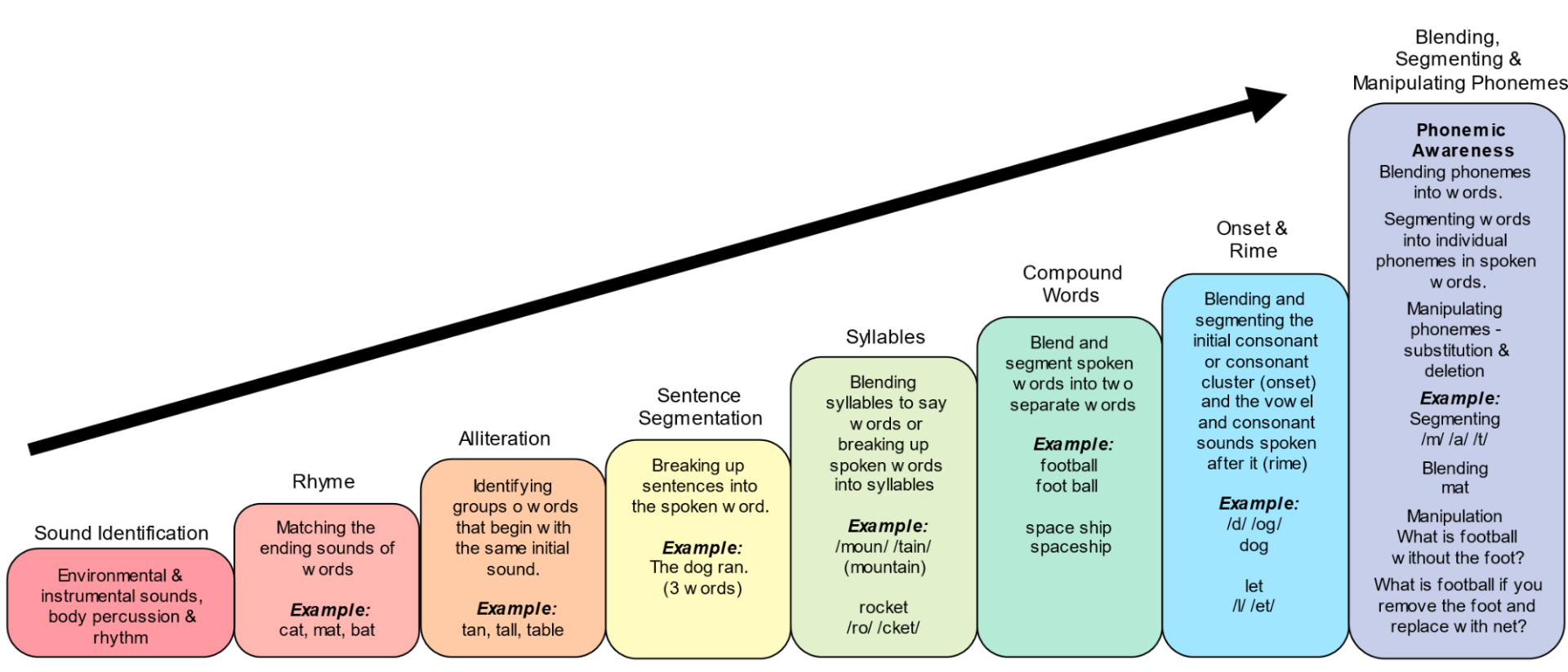
Some More Terminology
VC / CVC / CVCC / CCVC / CCVCC – Abbreviations used to describe the order of letters in words.
VC-vowel-consonant(am)
CVC-consonant-vowel-consonant(ham)
CCVC / CVCC -consonant-consonant-vowel-consonant(slam) / consonant-vowel-consonant-consonant (tent)
CCVCC - consonant-consonant-vowel-consonant-consonant (stamp)
digraph – A grapheme containing two letters that makes one sound (phoneme), e.g. sh, oo, or
trigraph – A grapheme containing three letters that makes one sound (phoneme), e.g. igh, air, ear
vowel digraph – A digraph in which at least one of the letters is a vowel, e.g. ea, ay, ai, ar
split digraph – Two letters, that work together to make one sound, but are separated within the word, e.g. a-e as in made, i-e as in like
high frequency words – High frequency words are words that recur frequently in print. The first 300 HFW make up 65% of all printed words.
common exception words / tricky words – Those words which cannot be sounded out easily. They are words where the graphemes do not make the sounds you would expect e.g. was
Phase 2 – Single-Letter Sounds
In the next phase, children begin to learn letter sounds and to match them to graphemes.
Most of the first sounds are single-letter sounds but there are also several digraphs, where one sound is represented by two letters, e.g., ‘ck’, ‘ll’, ‘ss’.
Children also begin to blend the sounds to make words. By the end of Phase 2, children will be able to read some ‘vowel-consonant’ (vc) and ‘consonant-vowel-consonant’ (cvc) words, e.g., up, in, cat, pin. Children will also learn to read some common exception words.
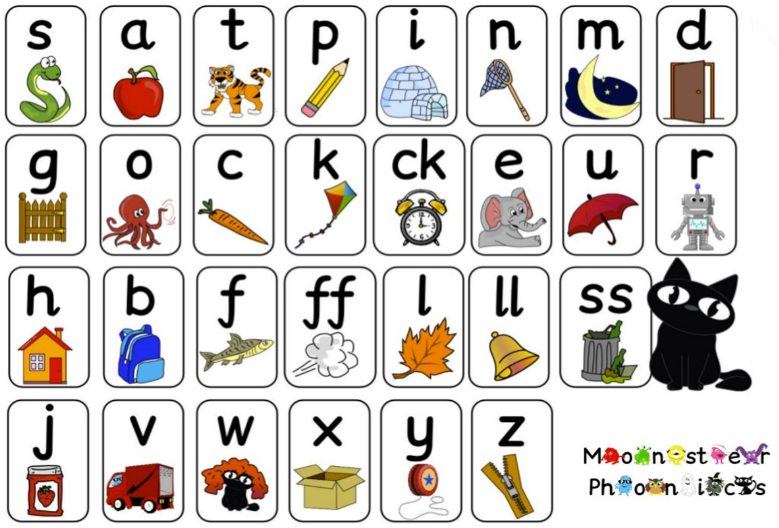
Phase 3 – Consonant and Vowel Digraphs
In this phase children are taught another 25 graphemes. The final single-letter sounds are taught, together with more consonant digraphs (e.g. zz, qu, ng, th, sh, ch) and the most common spelling of many vowel digraphs (e.g. ai, ee, igh, oa, ow).
Children also continue to learn how to blend and segment CVC words using the new sounds, e.g. tail, sheet, night – note that these words still only have three sounds.
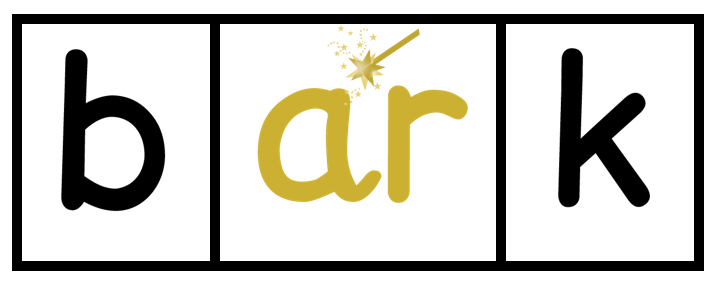
Children will then move on to blending and segmenting two-syllable words such as cooker, eating, broken. Common exception words also continue to be taught.
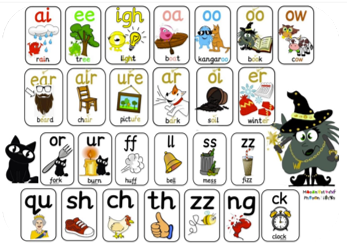
Phase 4 - Adjacent Consonants
By Phase 4, children are able to represent each of 44 phonemes with a grapheme. Children will be able to read CVC words and begin to segment them to spell them. Phase 4 is consolidation of children’s knowledge.
Children also move on to blending and segmenting using adjacent consonants, e.g., st, sp, tr, br, spr, str in words such as string, blow, train.
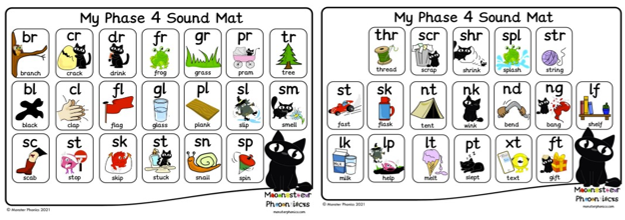
Phase 5 - Alternative Spellings
Children will broaden their knowledge of graphemes and phonemes. They will learn alternative ways of spelling the phonemes they have already learnt and learn strategies to help them choose the correct grapheme for spelling. Children will be reading with more and more fluency, no longer needing to ‘sound out’ most familiar words.
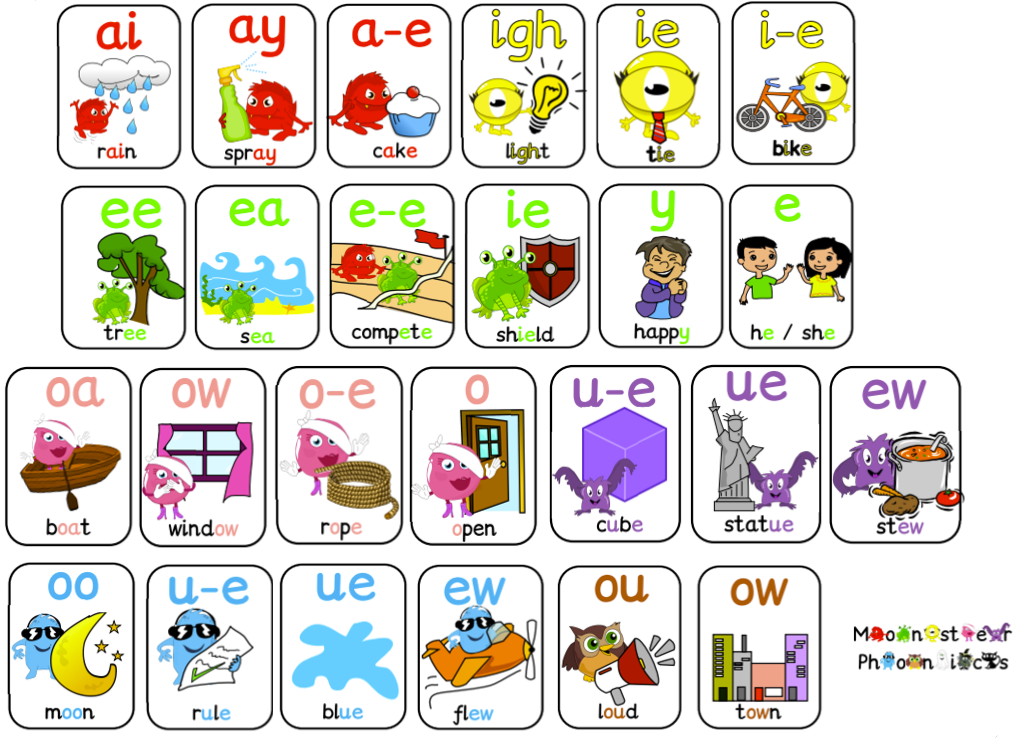
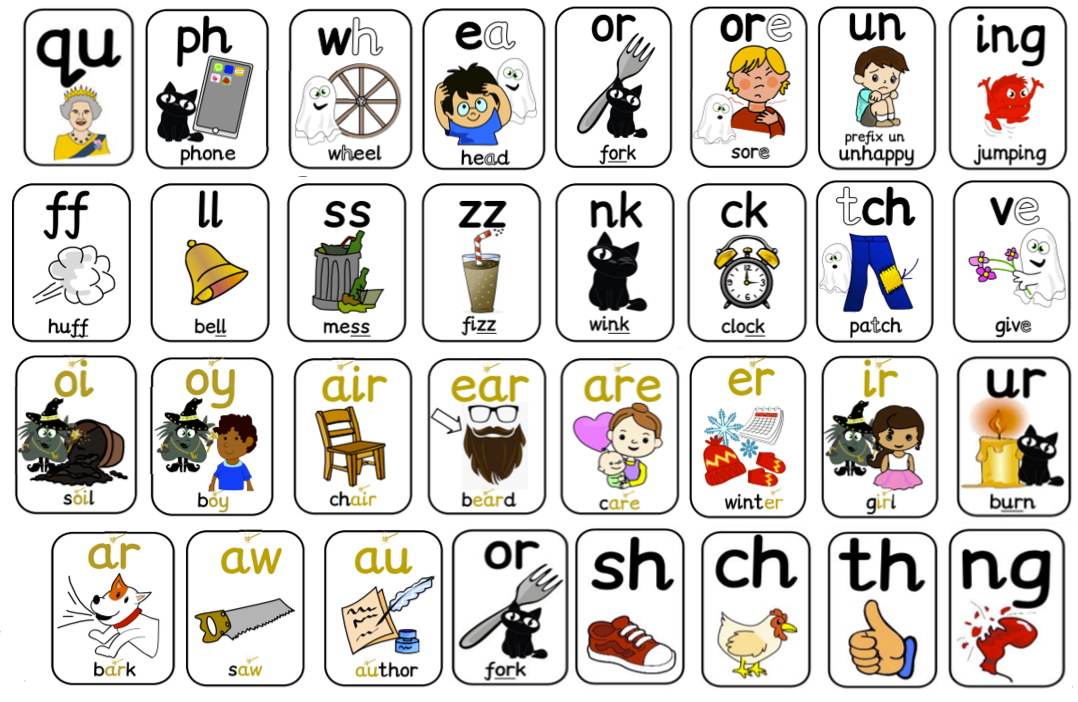
Phase 6 and Beyond
Phase 6 is mainly taught as children progress through year 2 (age 6-7). Children are becoming fluent readers and more accurate spellers. They learn more spelling patterns such as the use of prefixes and suffixes, contracted forms of words (e.g. can’t, won’t) and other words in common usage such as days of the week and months of the year.
At this stage, children can read hundreds of words automatically. They are now reading more for pleasure and reading to learn rather than learning to read. They can decode words quickly and silently and only need to sound out longer or more unfamiliar words.
Sounds of the English Phonic Code
There are lots of videos on YouTube that describe how sounds are pronounced but not all of them demonstrate correctly. It's important to recognise that we mustn't say "uh" at the end of the phoneme (so "m" is spoken as "mmmmm" and not "muh"). This might take a bit of practice!
To help, here is a video demonstrating the accurate pronunciation:
Sounds of the English Phonic Code -Synthetic Phonics.wmv - YouTube presented by Tami Reis-Frankfort, a reading specialist and trainer.
Phonics at Whitegrove
![]() At Whitegrove, we use Monster Phonics to support our teaching and learning of Phonics.
At Whitegrove, we use Monster Phonics to support our teaching and learning of Phonics.
Monster Phonics uses colour-coding and monsters to make the grapheme-phoneme (letter-sound) correspondence easier for children to learn and remember. The colour-coding of graphemes linked to phoneme monsters makes phonics easier to understand and the children love the monsters, who bring phonics to life for them! Activities are multisensory and include reading, writing, singing and actions.
Phonics takes place daily in EYFS & KS1. The children also receive three guided reading sessions within their phonics groups using the Monster Phonics decodable reading books which are closely linked to the sounds the children have been learning in their phonics lessons. The book is then sent home with the children at the end of the week to read at home with their parents.
Parent Workshops
We hold parent workshops throughout the year to help parents in supporting their children through their phonics journey.

